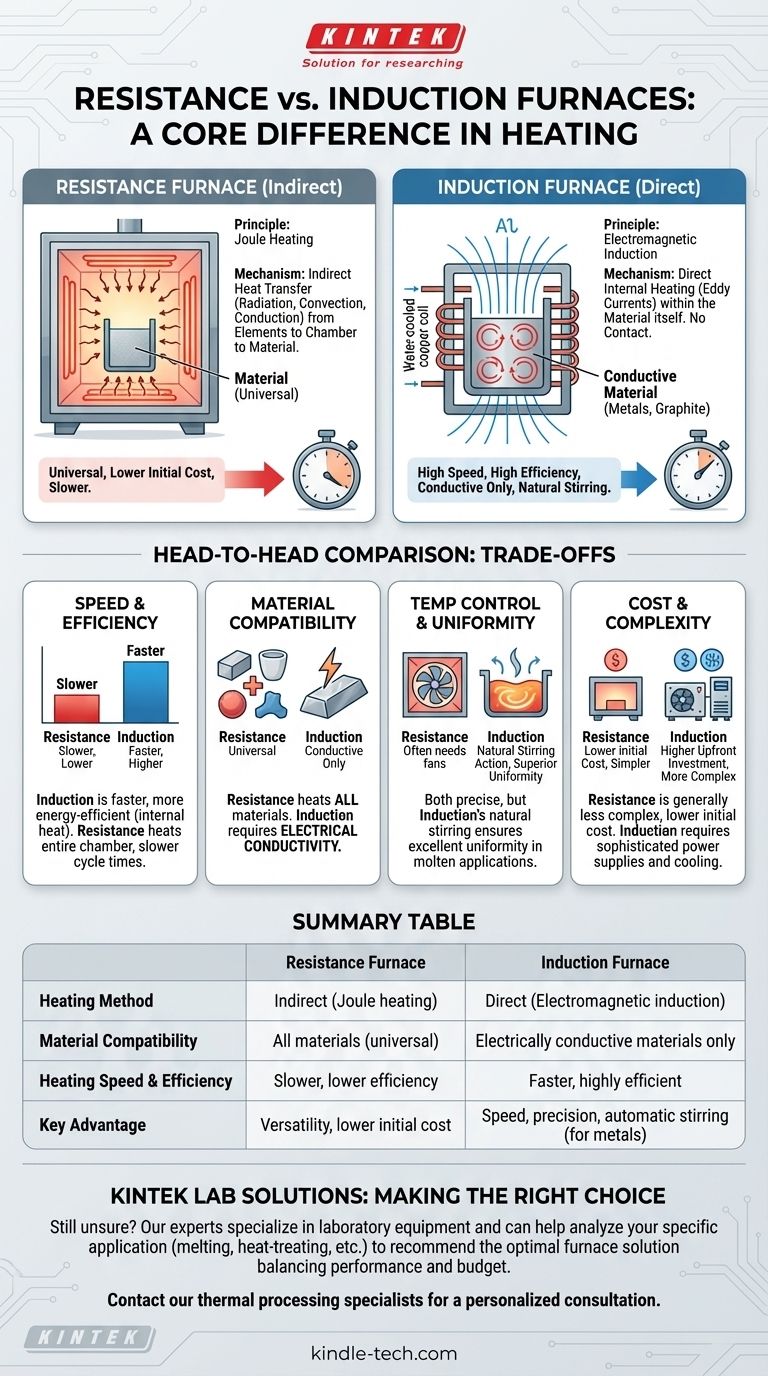저항로와 유도로의 근본적인 차이점은 가열 방법에 있습니다. 저항로는 가열 요소가 뜨거워져 재료에 간접적으로 열을 전달하는 방식으로 작동하며, 이는 일반적인 오븐과 매우 유사합니다. 반면 유도로는 전자기장을 사용하여 전도성 재료 내부에서 직접 열을 발생시키며, 물리적인 접촉은 없습니다.
이 두 기술 사이의 핵심 결정은 다용도성과 효율성 사이의 균형에 달려 있습니다. 저항로는 모든 재료를 가열하는 데 사용되는 보편적인 도구인 반면, 유도로는 금속과 같은 전도성 재료를 위한 고속, 고효율 전문가입니다.
저항로 작동 방식
저항로는 가장 일반적이고 간단한 유형의 전기로로, 토스터나 전기 스토브를 사용해 본 사람이라면 누구나 익숙한 원리로 작동합니다.
원리: 줄 가열
메커니즘은 전기 저항을 기반으로 합니다. 높은 전류가 고저항 재료로 만들어진 특수 설계된 가열 요소를 통과합니다.
전류의 흐름에 대한 이러한 저항으로 인해 요소는 매우 뜨거워지며, 이를 줄 가열(Joule heating)이라고 합니다.
메커니즘: 간접 열 전달
이러한 요소에서 발생하는 강렬한 열은 노 내부에 있는 재료로 전달됩니다. 이는 복사, 대류 및 전도의 조합을 통해 발생합니다.
본질적으로, 노는 챔버의 대기와 벽을 가열하고, 이는 다시 대상 재료를 가열합니다. 이는 간접적인 가열 과정입니다.
주요 특징
저항로는 전도성이든 아니든 모든 유형의 재료를 가열할 수 있는 다용도성으로 알려져 있습니다. 일반적으로 설계가 더 간단하고 초기 비용이 저렴합니다.

유도로 작동 방식
유도 가열은 재료에 열 에너지를 전달하는 방식을 근본적으로 바꾸는 보다 발전되고, 목표 지향적이며, 효율적인 방법입니다.
원리: 전자기 유도
유도로는 강력한 코일을 사용하여 빠르게 교류하는 자기장을 생성합니다. 강철이나 흑연과 같은 전도성 재료가 이 자기장 내에 놓이면, 자기장이 재료 자체 내부에 전류를 유도합니다.
이러한 작고 원형의 전류를 와전류라고 합니다.
메커니즘: 직접 내부 가열
이러한 와전류에 대한 재료의 자연적인 저항은 내부에서 외부로 정확하고 빠른 열을 발생시킵니다. 외부 가열 요소는 필요하지 않습니다.
열은 작업물 내부에서 직접 생성되므로, 주변 공간을 가열하는 데 에너지가 거의 낭비되지 않아 공정이 매우 빠르고 효율적입니다.
주요 특징
용융 금속에 대한 유도 가열의 독특한 이점은 자기장에 의해 발생하는 자연스러운 교반 작용입니다. 이는 기계적 교반기 없이도 뛰어난 온도 균일성과 합금 혼합을 보장합니다.
장단점 이해: 정면 비교
올바른 노를 선택하려면 각 가열 방법의 고유한 장점과 한계를 이해해야 합니다.
가열 속도 및 효율성
유도로는 훨씬 빠르고 에너지 효율적입니다. 열이 내부에서 생성되기 때문에 목표 온도에 도달하는 시간이 훨씬 짧고, 환경으로 손실되는 에너지가 적습니다.
저항로는 먼저 요소와 전체 노 챔버를 가열해야 하므로 사이클 시간이 느려지고 전반적인 효율성이 낮아집니다.
재료 호환성
저항로는 보편적입니다. 작동이 재료의 전기적 특성에 의존하지 않으므로 금속, 세라믹, 폴리머 및 복합 재료를 문제없이 가열할 수 있습니다.
유도로는 전문가용입니다. 매우 효과적이지만 전기 전도성 재료만 가열할 수 있습니다.
온도 제어 및 균일성
두 유형 모두 높은 수준의 온도 제어를 달성할 수 있습니다. 그러나 유도로의 자연스러운 교반 효과는 용융 금속 응용 분야에서 우수한 열 균일성을 제공합니다.
저항로에서 높은 균일성을 달성하려면 종종 분위기를 순환시키기 위한 팬이 필요하며, 이는 복잡성을 증가시킵니다.
비용 및 복잡성
저항로는 일반적으로 덜 복잡하고 초기 비용이 낮습니다. 유지 보수도 종종 더 간단하고 수명 기간 동안 비용이 적게 듭니다.
유도로는 더 복잡한 시스템으로, 정교한 전원 공급 장치와 냉각 시스템이 필요하므로 초기 투자 비용이 더 높습니다.
귀하의 응용 분야에 적합한 선택
최종 결정은 귀하의 특정 재료, 공정 요구 사항 및 예산에 따라 전적으로 결정되어야 합니다.
- 다용도성과 낮은 초기 비용이 주요 초점이라면: 저항로가 우수한 선택이며, 다양한 재료 및 응용 분야에 대한 신뢰할 수 있는 작업마차 역할을 합니다.
- 속도, 에너지 효율성 및 전도성 금속 가공이 주요 초점이라면: 유도로는 특히 용융, 브레이징 또는 고속 열처리 분야에서 탁월한 성능을 제공합니다.
- 세라믹과 같은 비전도성 재료를 다루는 경우: 저항로가 유일한 실행 가능한 옵션입니다.
- 용융 금속 욕조의 자동 교반이 필요한 경우: 유도로의 고유한 전자기 교반은 주요 운영 이점입니다.
이러한 가열 메커니즘의 근본적인 차이를 이해하는 것이 특정 열처리 작업에 가장 효과적인 도구를 선택하는 열쇠입니다.
요약표:
| 특징 | 저항로 | 유도로 |
|---|---|---|
| 가열 방법 | 간접 (줄 가열) | 직접 (전자기 유도) |
| 재료 호환성 | 모든 재료 (범용) | 전기 전도성 재료만 |
| 가열 속도 및 효율성 | 느림, 낮은 효율성 | 빠름, 높은 효율성 |
| 주요 장점 | 다용도성, 낮은 초기 비용 | 속도, 정밀도, 자동 교반 (금속용) |
아직 연구실의 특정 재료 및 공정에 어떤 노가 적합한지 확실하지 않으신가요?
KINTEK은 실험실 장비 및 소모품을 전문으로 합니다. 당사의 전문가들은 귀하의 응용 분야 요구 사항(금속 용융, 합금 열처리 또는 세라믹 가공 여부)을 분석하여 성능, 효율성 및 예산의 균형을 맞춘 최적의 노 솔루션을 추천해 드릴 수 있습니다.
오늘 열처리 전문가에게 문의하여 맞춤형 상담을 받고 올바른 노가 연구실의 생산성과 결과를 어떻게 향상시킬 수 있는지 알아보십시오.
시각적 가이드

관련 제품
- 1400℃ 실험실용 알루미나 튜브 머플로
- 알루미나 튜브가 있는 1700℃ 실험실 석영 튜브 퍼니스 튜브 퍼니스
- 수직 실험실 석영 튜브 퍼니스 튜브형 퍼니스
- 실험실 석영 튜브로 RTP 가열로
- 실험실용 1800℃ 머플로 퍼니스



















